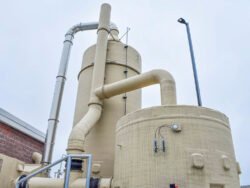
Pima County Wastewater Reclamation Facility
Pima County Wastewater Reclamation Facility: Leading the way in sustainable water management
Introduction
Water is a precious resource, especially in arid regions like southern Arizona. With limited rainfall and increasing demands for water from a growing population, it is crucial to find innovative solutions for managing water resources effectively. One such solution is wastewater reclamation, a process that treats and purifies wastewater to make it suitable for reuse.
In Pima County, Arizona, the Pima County Wastewater Reclamation Facility is leading the way in sustainable water management. This state-of-the-art facility uses advanced technology to treat and reclaim wastewater, providing a valuable source of water for irrigation, industrial processes, and even drinking water. In this article, we will explore the history of the facility, its innovative technology, and its role in promoting water conservation and sustainability in the region.
History of the Pima County Wastewater Reclamation Facility
The Pima County Wastewater Reclamation Facility (WRF) was originally built in the 1950s to treat wastewater from the growing population in Tucson and surrounding areas. Over the years, the facility has undergone several expansions and upgrades to meet the increasing demands for water treatment and reclamation.
In the 1970s, the facility began to focus on reclamation as a way to alleviate pressure on the region’s limited water supply. By treating and reclaiming wastewater, the facility could provide a reliable source of water for irrigation, industrial use, and groundwater recharge. In the 1990s, the facility began to explore potable reuse, a process that treats wastewater to drinking water standards, making it safe for human consumption.
Today, the Pima County WRF is one of the largest and most advanced wastewater reclamation facilities in the United States. With a capacity to treat over 50 million gallons of wastewater per day, the facility plays a crucial role in sustainable water management in the region.
Innovative Technology at the Pima County WRF
The Pima County WRF uses a combination of advanced technologies to treat and reclaim wastewater. The treatment process begins with screening and grit removal to remove large debris and particles from the wastewater. The wastewater then undergoes primary treatment, where solids are settled out and removed.
Next, the wastewater goes through secondary treatment, where microorganisms break down organic matter in the water. This process, known as activated sludge treatment, removes pollutants and contaminants from the water, making it cleaner and safer for reuse. The treated wastewater is then disinfected using UV light or chlorination to kill any remaining pathogens.
One of the most innovative aspects of the Pima County WRF is its advanced water reclamation technology. The facility uses a combination of reverse osmosis, ultrafiltration, and advanced oxidation processes to further treat the wastewater to drinking water standards. This process removes virtually all contaminants from the water, producing high-quality reclaimed water that is safe for human consumption.
In addition to potable reuse, the Pima County WRF also produces reclaimed water for irrigation and industrial use. The facility has a distribution system that delivers reclaimed water to golf courses, parks, and other non-potable water users in the region. This helps to reduce the demand for potable water and promotes water conservation in the community.
The Role of the Pima County WRF in Promoting Water Conservation and Sustainability
The Pima County Wastewater Reclamation Facility plays a crucial role in promoting water conservation and sustainability in the region. By treating and reclaiming wastewater, the facility provides a valuable source of water for irrigation, industrial processes, and even drinking water. This helps to reduce the demand for potable water and alleviate pressure on the region’s limited water supply.
In addition to producing reclaimed water, the Pima County WRF also plays a key role in educating the public about water conservation and sustainable water management practices. The facility offers tours and educational programs for schools, community groups, and other interested parties to learn about the water treatment process, the importance of water conservation, and the benefits of using reclaimed water.
Furthermore, the Pima County WRF collaborates with local water agencies, municipalities, and organizations to promote water reuse and sustainability in the region. The facility works closely with the Pima County Regional Wastewater Reclamation Department, the City of Tucson Water Department, and other stakeholders to develop water reuse projects, implement water conservation programs, and conduct research on water quality and sustainability.
Overall, the Pima County Wastewater Reclamation Facility is a shining example of sustainable water management in action. By treating and reclaiming wastewater, the facility provides a reliable source of water for irrigation, industrial processes, and even drinking water, helping to conserve potable water and promote sustainability in the region.
Conclusion
The Pima County Wastewater Reclamation Facility is a leading example of sustainable water management in the United States. With its advanced technology, innovative water reclamation processes, and commitment to promoting water conservation and sustainability, the facility plays a crucial role in managing water resources effectively in the arid region of southern Arizona.
As water scarcity becomes an increasingly pressing issue around the world, facilities like the Pima County WRF offer a model for how communities can reclaim and reuse wastewater to meet their water needs. By investing in water reclamation technology, promoting water conservation practices, and educating the public about the importance of sustainable water management, we can ensure a reliable and sustainable water supply for future generations.
Sources:
1. Pima County Regional Wastewater Reclamation Department. “About Us.” https://webcms.pima.gov/cms/one.aspx?portalId=169&pageId=217
2. City of Tucson Water Department. “Water Reclamation.” https://www.tucsonaz.gov/water/water-reclamation
3. Water Environment Federation. “Wastewater Treatment Plants of the Future.” https://www.wef.org/resources/publications/wef-reports/wastewater-treatment-plants-of-the-future/
